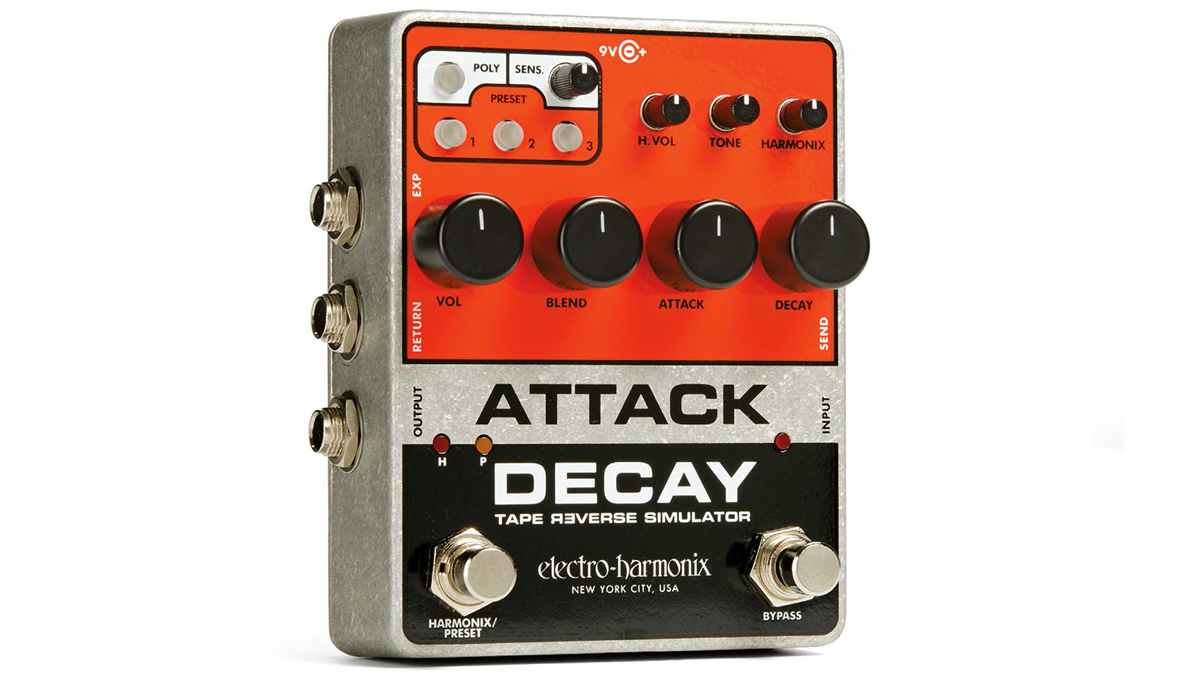Review: Electro-Harmonix's Attack Decay delivers a vast universe of exciting new sounds to explore
This dramatic reboot of the Tape Reverse Simulator pedal significantly expands upon the capabilities of the original

Electro-Harmonix has finally brought back the coveted Attack Decay pedal originally produced in very small quantities from 1980-81, but rather than releasing a throwback reissue they’ve done a dramatic reboot that significantly expands upon the capabilities of the original.
In addition to the original tape reverse simulator and automatic volume swell effects, the new Attack Decay pedal provides three selectable attack and decay shapes in mono mode, a highly expressive poly mode, a digital fuzz circuit with a complete set of controls, triggered tremolo effects, an effects loop, three preset memory locations and much more. Best of all, the new version adds about 10 times more power at a street price that’s about one tenth of the original pedal’s price on the vintage market.
FEATURES
With four knobs for the main Attack Decay parameters (Volume, Blend, Attack and Decay), three mini knobs for the Harmonix fuzz (Harmonix Volume, Tone and Harmonix), a mini Sensitivity knob, three preset pushbuttons and a Poly mode pushbutton, the Attack Decay pedal looks deceptively simple. However, numerous custom settings and functions are accessible by holding down different combinations of the pushbuttons and/or footswitches (Harmonix/Preset and Bypass) so it’s important to read the manual to get the most out of the box.
In addition to ¼-inch input and output jacks, the pedal also provides ¼-inch send and return jacks and a ¼-inch expression pedal jack. The Attack Decay operates via an included 9-volt power supply only (no battery power option).
PERFORMANCE
While the Attack Decay pedal produces truly awesome tape reverse effects that are extremely easy to control in live performance, this effect is just the tip of the iceberg. I found the automatic volume swells even more useful (a la Cathedral and Since We’ve Ended as Lovers) and loved using poly mode for authentic pedal steel-style effects. Dialing in a fast attack with short decay produces staccato sounds that can sound like a banjo, koto, or synth, and the triggered tremolo generates inspiring rhythmic effects.
The Harmonix digital fuzz circuit is worth the pedal’s surprisingly affordable price all on its own, and thanks to the Attack Decay’s three presets you could use it as a standalone fuzz in addition to two other effects, saving space on your pedalboard. Patching various effects into the pedal’s effect loop significantly expands its creative capabilities, but even without taking advantage of this feature the Attack Decay provides an impressive wealth of highly inspiring effects to stimulate your creativity.
LIST PRICE: $166.70
MANUFACTURER: Electro-Harmonix, ehx.com
Get The Pick Newsletter
All the latest guitar news, interviews, lessons, reviews, deals and more, direct to your inbox!
• Mono mode provides selectable linear, parabolic and S envelope curves for the attack and decay individually for an even wider range of textures.
• The three preset buttons enables users to save three radically different effects and access them instantly.
THE BOTTOM LINE: Much more than the Tape Reverse Simulator effect hyped by the product name, the Attack Decay pedal’s versatile envelope-manipulation controls, built-in digital fuzz circuit and hidden functions deliver a vast universe of exciting new sounds to explore.
Chris is the co-author of Eruption - Conversations with Eddie Van Halen. He is a 40-year music industry veteran who started at Boardwalk Entertainment (Joan Jett, Night Ranger) and Roland US before becoming a guitar journalist in 1991. He has interviewed more than 600 artists, written more than 1,400 product reviews and contributed to Jeff Beck’s Beck 01: Hot Rods and Rock & Roll and Eric Clapton’s Six String Stories.
“Jimi was staying at a hotel in Times Square. He had his hair set in pink curlers and we would just talk band drama”: Electro-Harmonix founder Mike Matthews on befriending Hendrix, booking Chuck Berry and the birth of pedal culture
“Our answer to everything players have asked for and more”: Neural DSP’s Nano Cortex had one major drawback – but now it’s been addressed with a huge free firmware update that takes on Kemper and TONEX





![[from left] George Harrison with his Gretsch Country Gentleman, Norman Harris of Norman's Rare Guitars holds a gold-top Les Paul, John Fogerty with his legendary 1969 Rickenbacker](https://cdn.mos.cms.futurecdn.net/TuH3nuhn9etqjdn5sy4ntW.jpg)





